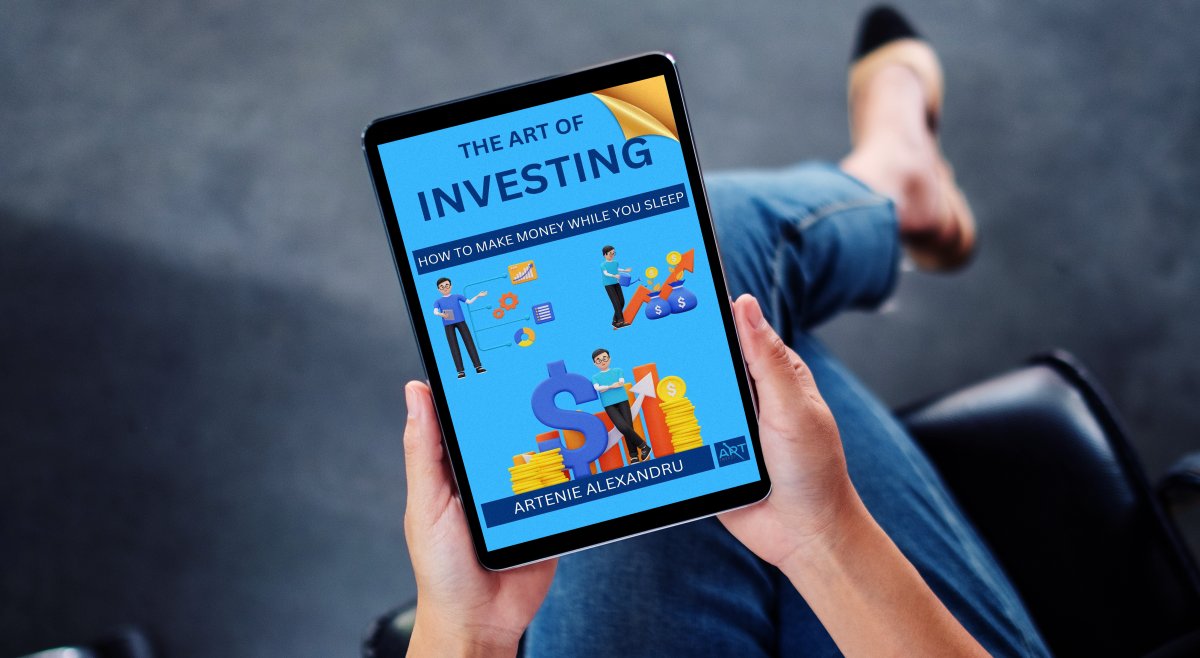The Art of Investing by Artenie Alexandru
How to Make Money While You Sleep
Learn How to Choose Stocks and Find Your Way to Wealth, Prosperity and Financial Freedom through Stock Market and Passive Income Streams
Master the Art of Investing in the Stock Market and Discover Your Way to Financial Freedom!
Ever wanted to start investing but wondered how? Or are you already an investor but need un uplifting?
You will get proven lessons to learn investing principles, which will help you confidently make your first steps in the journey.
The Art of Investing goes beyond traditional investment advice, delving into the psychology of wealth creation. Gain the mindset of a savvy investor, mastering the art of risk management and decision-making. Learn to trust your instincts and seize opportunities at the right time.
Imagine making money while you sleep! This is only possible through investing.
You will learn about the following:
- How to identify investing opportunities – they occur more often than you think
- What are the ways of making money in the stock market – it’s not only about buying low, selling high
- How to pick your winning stock – so that you are also a winner When to enter a trade – you will benefit from technical analysis
- Get unique investing checklists – so that you don’t miss any important point
- How to properly diversify – that’s your free lunch in finance
- Build your first strategy – you will find what fits best for you
You will be happy to find inside:
- Many Fast Facts to drive your fancy
- Plenty of pictures to explain the matters
- Concepts backed by an impressive pool of real-life examples
At the end of the book, you will find an Annex with tools and websites, both free and paid, as well as extra explanations of important terms you need to know. Ensure you read them also, as they will help you become a better investor.
AmazonExcerpt from The Art of Investing © Copyright 2023 Artenie Alexandru
Introduction
Dare to dream about Financial Freedom!
Most people believe financial security means saving as much as possible. In reality, that's not entirely true. Financial security is a combination of saving and investing.
If you just save, there's a good chance you will have to work till your last day. But when you invest, your money grows by itself! And when you add regular investments to your savings, you can take control of your life and plan it.
You did an excellent service to yourself by considering this book as a first step.
This is because I will walk you pragmatically through the essential aspects. Then, after reading it, you will be familiar with the most used concepts, be able to do your research and have your first strategy.
Financial Independence is accessible to you and anybody else!
Why Invest
By definition, investing is allocating resources, usually money, to generate an income or profit.
Although it might be obvious why you should invest, let’s examine this as a form of financial wisdom.
First, investing allows you to minimize the impact or overcome inflation; God knows, we had enough of it in 2022 and throughout history.
If you keep your money in your pocket or the bank account, it loses its practical value with time. That means, as time passes, you can buy less and less with the same amount of dollars.
Here is a nice picture from investopedia.com illustrating the effect of inflation on a coffee price example:
Figure 1– Impact of Inflation. Source: Investopedia
By investing your money and increasing their amount, you can at least keep your buying power constant.
Below is a picture that shows the annual inflation rate in the US for the last century. As higher the indicator is, the more purchase power your cash loses.
Figure 2 – US Annual Inflation Rate. Source: TradingEconomics
Fast Fact:
The movie Cleopatra cost $44 million to make in 1963. With inflation considered, the same film would cost $350 million today.
Investing is also a good source of passive income. That means you make money while you are sleeping. Sounds tempting, isn’t it?
It is always nice to have some extra cash to cover your expenses. But imagine how awesome it would be to pay your monthly bills just by the earnings of your investments and with almost no active involvement from your side! That’s kind of a “living for free.”
Extending this idea to an upper level brings us to the third point:
Financial Freedom. In other words, cover your life spending entirely with your investment returns. Epic!
Of course, you would need to invest a lot of money to earn a living out of that, but investing is probably the best way to stop trading your time for money.
Where to invest
Probably you've heard a thousand times how investments can be financial vehicles to help you turn your dreams into reality, but you need guidance about where to start. Beyond having the money to invest, where to invest is also an important consideration.
There are different investment options, each offering unique advantages and risks. Hence, it will be advisable to look into some of these investment means to decide which is most suitable for you.
Here, I've explained some investment tools to help you make a choice.
The Stock Market
The stock market is one of the most popular investment choices. The stock market is a market that facilitates buying and selling stocks, also known as shares. Stocks here represent publicly traded companies – they allow the public to buy their shares.
By buying the shares of a company, you become entitled to the assets and profits of that company. Stocks are, therefore, a financial instrument that grants you individual ownership of a proportion of a company's assets and earnings. However, the number of shares you buy will determine the slice of the company you own.
Investing in the stock market can be an excellent source of income, especially when you invest in a well-performing stock over the long term. Yet, you must have a high-risk tolerance to invest in stocks as the stock market is highly volatile.
Figure 3 – Annual return of the S&P500 index since 1928. Source: Macrotrends
The above picture clearly expresses the stock market volatility. However, the average annual return is positive and lies between 7 – 10%. Note that the performance observed is strongly dependent on the analyzed period.
Figure 4 – S&P500 index average return for different periods. Source: Nerdwallet
My profession is online marketing and development (10+ years experience), check my latest mobile app called Upcoming or my Chrome extensions for ChatGPT. But my real passion is reading books both fiction and non-fiction. I have several favorite authors like James Redfield or Daniel Keyes. If I read a book I always want to find the best part of it, every book has its unique value.







